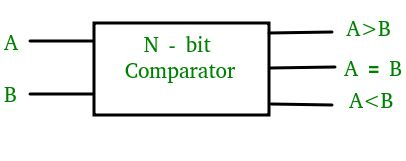One Bit Comparator using 74LS86
Aim
To study and verify the One Bit Comparator using 74LS86.Learning Objectives
- To understand the behavior and demonstrate One Bit Comparator using 74LS86.
- To apply knowledge of the fundamental gates to create truth tables.
- To develop digital circuit building and troubleshooting skills.
- To understand key elements of TTL logic specification or datasheets.
IC Used
| IC Number | IC Name |
|---|---|
| 74LS04 | Hex Inverting Gates |
| 74LS08 | Quad 2-input AND Gates |
| 74LS86 | Quad 2-input Exclusive-OR Gates |
Circuit Tutorials:
Procedure
- Place the IC on IC Trainer Kit.
- Connect VCC and ground to respective pins of IC Trainer Kit.
- Implement the circuit as shown in the circuit diagram.
- Connect the inputs to the input switches provided in the IC Trainer Kit.
- Connect the outputs to the switches of O/P LEDs
- Apply various combinations of inputs according to the truth table and observe the condition of LEDs.
- Note down the corresponding output readings for various combinations of inputs.
- Power Off Trainer Kit, disconnect all the wire connections and remove IC's from IC-Base.
Theory
1-Bit Magnitude Comparator - The Digital Comparator is another very useful combinational logic circuit used to compare the value of two binary digits. A magnitude digital Comparator is a combinational circuit that compares two digital or binary numbers in order to find out whether one binary number is equal, less than or greater than the other binary number. We logically design a circuit for which we will have two inputs one for A and another for B and have three output terminals, one for A > B condition, one for A = B condition and one for A < B condition.
A comparator used to compare two bits is called a single bit comparator. It consists of two inputs each for two single-bit numbers and three outputs to generate less than, equal to and greater than between two binary numbers

Digital comparators actually use Exclusive-NOR gates within their design for comparing their respective pairs of bits. When we are comparing two binary or BCD values or variables against each other, we are comparing the “magnitude” of these values, a logic “0” against a logic “1” which is where the term Magnitude Comparator comes from.
Block Diagram

Precautions
- Make the connections according to the IC pin diagram.
- The connections should be tight on trainer kit.
- The Vcc and ground should be applied carefully at the specified pin only.
Conclusion
We have learned the One Bit Comparator using 74LS86.Recommendations
Implementation of 4-Bit Magnitude Comparator using IC-74LS85
Aim: To study and Implement 4-Bit Magnitude Comparator using IC-74LS85.
ICs used: 74LS85 One Bit Comparator
Aim: To study and verify the One Bit Comparator.
ICs used: 74LS0474LS0874LS02 8 Bit Comparator Using 74LS85
Aim: To study and Verify the 8 Bit Comparator Using 74LS85.
ICs used: 74LS85